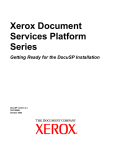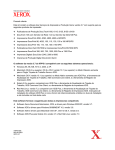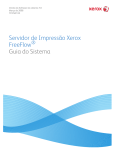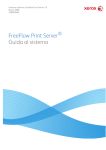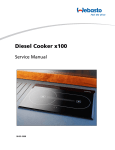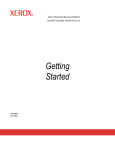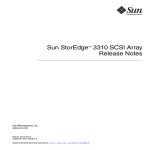Download Xerox 701P46985 Printer User Manual
Transcript
Version 6.0.xx, May 2007 701P46985 Getting ready for the ® ® Xerox FreeFlow Print Server Installation Prepared by: Xerox Corporation Global Knowledge and Language Services 800 Philips Road Bldg. 845-17S Webster, New York 14580 USA ©2007 by Xerox Corporation. All rights reserved. Copyright protection claimed includes all forms and matters of copyrightable material and information now allowed by statutory judicial law or hereinafter granted, including without limitation, material generated from the software programs displayed on the screen such as icons, screen displays, or looks. Printed in the United States of America. XEROX® and all Xerox product names mentioned in this publication are trademarks of XEROX CORPORATION. Other company trademarks are also acknowledged. Changes are periodically made to this document. Changes, technical inaccuracies, and typographic errors will be corrected in subsequent editions. Product Recycling and Disposal If you are managing the disposal of your Xerox product, please note that the product contains lead, mercury, and other materials whose disposal may be regulated due to environmental considerations in certain countries or states. The presence of lead and mercury is fully consistent with global regulations applicable at the time that the product was placed on the market. European Union Some equipment may be used in both a domestic/household and a professional/business application. Domestic/Household Environment Application of this symbol on your equipment is confirmation that you should not dispose of the equipment in the normal household waste stream. In accordance with European legislation end of life electrical and electronic equipment subject to disposal must be segregated from household waste. Private households within EU Member States may return used electrical and electronic equipment to designated collection facilities free of charge. Please contact your local disposal authority for information. In some Member States when you purchase new equipment your local retailer may be required to take back your old equipment free of charge. Please ask your retailer for information. Professional/Business Environment Application of this symbol on your equipment is confirmation that you must dispose of this equipment in compliance with agreed national Procedures. In accordance with European legislation end of life electrical and electronic equipment subject to disposal must be managed within agreed procedures. Prior to disposal please contact your local dealer or Xerox representative for end of life take back information. Table of contents Table of contents .................................................................................................................................................... 1 Installation worksheets.......................................................................................................................................... 1 Using the installation worksheets ..................................................................................................... 1 Available worksheets ..................................................................................... 2 About the worksheets .................................................................................... 4 W-1: Solaris operating system worksheet ..................................................... 5 W-2: Xerox Security worksheet ................................................................... 10 W-3: Xerox FreeFlow Print Server software worksheet .............................. 12 W-4: System configuration worksheet ......................................................... 14 W-5: Print Server software and gateways worksheet.................................. 17 W-6: Network configuration worksheet........................................................ 18 W-7: Novell NetWare gateway installation worksheet................................. 21 W-8: AppleTalk Gateway installation worksheet ......................................... 24 W-9: SNMP Gateway installation worksheet ............................................... 26 W-10: Client workstations ............................................................................ 27 W-11: Remote Services ............................................................................... 27 W-12: Data Overwrite and Backup Configuration........................................ 28 Installation worksheets The Getting Ready for the Xerox® FreeFlow® Print Server 6.0 Installation guide has been developed for you to use in the gathering of the technical data required by the Xerox personnel during installation of your customer’s print server hardware and software. It is used in conjunction with the appropriate printer installation planning guide. Using the installation worksheets The Xerox printer with FreeFlow Print Server software provides a wide range of network printing services on industry-standard networks, and consists of the following: • A UNIX-based computer workstation with a Xerox interface PWB and FreeFlow Print Server software installed. • A supported Xerox printer. Getting Ready for the Xerox FreeFlow Print Server 6.0 Installation contains the worksheets that must be completed to support the installation of the Xerox FreeFlow Print Server software on the server. When these worksheets are completed they will contain a record of the state of the system at the time of install. Most likely, this setup and configuration state will change, so encourage your customer to keep these worksheets with the service record of the printer for future reference. Your customer should not complete the worksheets if they are not sure of the required information. Always encourage them to contact the next level of technical support within their organization for assistance. NOTE: Worksheet W-5, the Novell NetWare gateway installation worksheet, refers to on-site setup requirements that your customer’s network administrator should already have implemented prior to the FreeFlow Print Server install. The values for the data elements entered during that setup activity should be recorded on this worksheet. XEROX FREEFLOW PRINT SERVER GETTING READY FOR THE PRINT SERVER INSTALLATION 1 FREEFLOW PRINT SERVER 6.0.xx Available worksheets The following is a list of the worksheets that support the installation of the FreeFlow Print Server software: • Worksheet W-1: Solaris Operating System software Complete this worksheet for each print server. This information is used by the Xerox service representative to install the Solaris operating system and is a required worksheet. • Worksheet W-2: Xerox Security This information is used by the Xerox service representative to set the appropriate level of security on the print server. This worksheet requires an understanding of the level of access required by the customer’s workflow and applications, such as the Xerox FreeFlow Prepress Suite. • Worksheet W-3: Xerox FreeFlow Print Server software Complete this worksheet for each print server. This information is used by the Xerox service representative to install the FreeFlow Print Server software. • Worksheet W-4: System configuration This information is used by the Xerox service representative to connect the print server to the Xerox printer and is a required worksheet. • Worksheet W-5: Xerox FreeFlow Print Server software and gateways This information is used by the Xerox service representative to ensure the proper licenses are loaded for the FreeFlow Print Server software. • Worksheet W-6: Network Configuration This information is used by the Xerox service representative to set up and configure the network configuration of the FreeFlow Print Server to match the customer’s site. The customer can also use this information to configure additional network information or to change the network configuration at some future date. • Worksheet W-7: Novell NetWare Gateway installation This information is used by the Xerox service representative to set up the Novell NetWare gateway. The customer can also use this information to set up the gateways on the print server after the gateways have been installed and licensed. 2 XEROX FREEFLOW PRINT SERVER GETTING READY FOR THE PRINT SERVER INSTALLATION FREEFLOW PRINT SERVER 6.0.xx • Worksheet W-8: AppleTalk Gateway installation This information is used by the Xerox service representative to set up the AppleTalk Gateway. This information can also be used by the customer to set up the AppleTalk Gateway after the gateway has been installed and licensed. • Worksheet W-9: SNMP Gateway installation This information can be used by either the Xerox service representative or the customer to set up the SNMP Gateway after the gateway has been installed and licensed. • Worksheet W-10: Client workstations This worksheet is used only when your customer has contracted Xerox to install additional document submission software or print drivers on their client workstations. • Worksheet W-11: PrInteract Remote Services Remote Services is an option that allows the customer to interact with Xerox through a web-based browser to resolve printing issues, download and install software patches, and send machine and job data to Xerox. The information collected on this worksheet is used by the Xerox service representative to set up the Remote Services software. • Worksheet W-12: Data Overwrite and Backup Configuration Data Overwrite software removes all data from the spool, swap, and outQ partitions of the FreeFlow Print Server hard disk. The data cannot be retrieved. The Backup Configuration utility allows customers to back up and restore system configuration files as well as Remote Services configuration files. The information collected on this worksheet is used by the Xerox service representative to set up the Data Overwrite and Backup Configuration features. XEROX FREEFLOW PRINT SERVER GETTING READY FOR THE PRINT SERVER INSTALLATION 3 FREEFLOW PRINT SERVER 6.0.xx About the worksheets The worksheets contain a combination of the following elements: • The Data Element column contains a list of the specific items of information needed to perform the procedure identified in the worksheet title. Definitions for the required data elements immediately follow each worksheet. • Use the Customer Value column to enter the necessary data element value. If the value is pre-determined, the value required is indicated in the column. Although necessary for install, it is up to your customer to decide whether these values should be entered in the tables. If the values are not available in the tables, make sure your customer will be able to provide the information during install. 4 XEROX FREEFLOW PRINT SERVER GETTING READY FOR THE PRINT SERVER INSTALLATION FREEFLOW PRINT SERVER 6.0.xx W-1: Solaris operating system worksheet The Xerox service representative uses the following information during the installation of the Solaris operating system on the print server. In the Customer Value column, fill in or circle the appropriate value where applicable. Bold text indicates a standard installation value. Item # Data Element 1 Primary Network Interface 2 DHCP 3 Hostname 4 IP Address (If DHCP is yes, then skip) 5 Subnets? Customer Value bge0 or bge1 or ce1 Yes No Yes No If Yes, then enter Subnet Mask 6 Enable IPv6? 7 Set the Default Route No Detect One Specify One None Default Router IP Address (Default gateway) (If Specify One, enter the Router IP Address) 8 Enable Kerberos Security? 9 Name Service Yes No NIS+ NIS DNS LDAP None Domain Name NIS+, NISS Locate server automatically Find one Specify If Specify, then NIS Server Hostname If Specify, then NIS Server IP Address Domain Name DNS DNS Server IP Address(es) (Enter up to 3 addresses) DNS Search List (Enter from 1 to 6) XEROX FREEFLOW PRINT SERVER GETTING READY FOR THE PRINT SERVER INSTALLATION 5 FREEFLOW PRINT SERVER 6.0.xx Domain Name LDAP Profile Name Profile Server IP Address 10 Geographic Region 11 Time Zone 12 Create System Backup Partition Yes No 13 Create Data Overwrite Partition (Required for Data Overwrite) Yes No 14 Space for System Backups 15 Security Profile High Medium Low Default Operating System Only 6 XEROX FREEFLOW PRINT SERVER GETTING READY FOR THE PRINT SERVER INSTALLATION FREEFLOW PRINT SERVER 6.0.xx W-1 data element definitions Primary Network Interface: Product Controller/Server Value iGen3 PDSI Config 4 bge0 DocuColor (2XX, 5000, 7000/8000) PDSi Config 2b, 2c, 2d bge0 DocuTech 61XX PDSi Config 2a bge0 SUN W1100z Determined automatically DocuTech 128/155/180 HLC PDSi Config 2a bge1 DocuTech 128/155/180 HLC SUN W1100z ce1 Xerox 41XX/45XX EPS, XXP SUN Ultra 20 Determined automatically Xerox Continuous Feed PDSi Config 4 bge1 Nuvera X86 Determined automatically DocuPrint 1XX EPS DocuTech 61XX DocuPrint 1XX EPS DHCP: Dynamic Host Configuration Protocol. This is a TCP/IP addressing method. If selected, the system should automatically contact the DHCP server to obtain the IP address, subnet mask, and default gateway address. This information can also be manually entered into the FreeFlow Print Server Network Configuration screens. DHCP is the default for DocuColor 2XX. iGen3 may not use DHCP. Hostname: This is the name the print server will be known as by users from other host machines on the TCP/IP network. This name is an alias mapped to the IP address that is assigned to the print server/host machine. The Hostname must start with an alphabetic character, and cannot start with a number, space, or any other non-alphabetic character. IP Address: The lP or Internet Address is a unique 4 byte, 32 bit numeric value that is assigned to each local host and workstation on a TCP/IP network. An IP address consists of four fields, each separated by a decimal point. For example: 13.254.166.111. NOTE: The TCP/IP Internet spans the entire world. The Internet central committee assigns a set of unique network addresses to XEROX FREEFLOW PRINT SERVER GETTING READY FOR THE PRINT SERVER INSTALLATION 7 FREEFLOW PRINT SERVER 6.0.xx your customer’s company. The customer network administrator assigns IP address numbers within this set to each host and workstation on the network. Subnets: A “YES” answer to this query indicates that your customer’s network is divided into segments or “subnets.” In this instance the following data element, subnet mask, must also be provided. Subnet Mask: The subnet mask is a decimal or hexadecimal group of four fields, each separated by a decimal point that indicates how much of the IP Address is used with the Network number to create subnets. The following is an example of a subnet mask in its decimal and hexadecimal form. 255.255.0.0 = 0xff.0xff.0x0.0x0 The subnet mask is derived by the network administrator according to how many subnets are needed. The subnet mask is the same for all hosts that exist on a given network. Your customer’s network administrator can provide this information. Ipv6: Internet protocol version 6. FreeFlow Print Server is not using this version of the Internet protocol at this time. Do not select this option. Default Router lP address: The default router IP address is a unique 4 byte, 32 bit numeric value, for example, 13.252.12.198 that identifies the machine that is acting as the main router. The router maintains tables of addresses of many networks in order to forward data packets between these networks. During install, the service representative creates a default router file on the print server, if one does not already exist, and this number is added to a line in the new file. Your customer’s network administrator should provide this number. NOTE: If another machine is not identified as the default router, the print server will automatically take over the main router function. This may noticeably slow down processing on the network. Kerberos Security: Kerberos security is a network authentication protocol that is provided with the Solaris environment. FreeFlow Print Server does not currently support this protocol. Name Service: DNS, NIS, NIS+, and LDAP are network information services that hold user information. None indicates that the user information is held locally. Additional information for each of these services should be entered in the appropriate table in W-6. The network services are enabled and configured using the FreeFlow Print Server Network Configuration screens. NOTE: In order to load and enable Remote Services, DNS must be the Name Service type. Geographic Region: Enter your customer’s geographical country or region. The selections available are Africa, Western 8 XEROX FREEFLOW PRINT SERVER GETTING READY FOR THE PRINT SERVER INSTALLATION FREEFLOW PRINT SERVER 6.0.xx Asia, Eastern Asia, Australia/New Zealand, Canada, Europe, Central America, South America, United States, Other (offset from GMT), and Other (specify rules file). Time Zone: Enter your customer’s time zone. The selections available are: Eastern, Central, Mountain, Pacific, Yukon, East—Indiana, Arizona, Michigan, Samoa, Aleutian, Hawaii, none of these (return to regional menu). Create System Backup Partition: Backup and Restore utilities provide a means to back up and restore either a complete system image or configuration files containing user settings. These utilities are only available if a system backup partition (XRXbackup) is created. The option to create the partition is selected by default. If the option is deselected, the backup partition is not created and additional disk space is available. NOTE: Xerox strongly recommends leaving this option checked. Create Data Overwrite Partition: Select this option to allocate space for the Data Overwrite Software feature. It is not selected by default. Space for System Backups: If the default value is not large enough, use this control to increase the value of the space allocated for backups. Increasing backup space reduces the amount of space allocated for root. Security Profile: Refer to the W-2 worksheet for the security profile definitions. XEROX FREEFLOW PRINT SERVER GETTING READY FOR THE PRINT SERVER INSTALLATION 9 FREEFLOW PRINT SERVER 6.0.xx W-2: Xerox Security worksheet Security is automatically installed and set to the default secure mode of Low. Security can be modified from High (fully secure) to None (not secure) through the FreeFlow Print Server interface. The System Administrator can modify the security levels through the FreeFlow Print Server user interface. For additional information on security, refer to the following table and the Xerox FreeFlow Print Server Security Guide. 10 XEROX FREEFLOW PRINT SERVER GETTING READY FOR THE PRINT SERVER INSTALLATION FREEFLOW PRINT SERVER 6.0.xx Profile Characteristics Value Legacy Compatibility Comments None • Default operating system only For customers that have a physically closed environment Close to DocuSP 2.1 / 3.1 with no adjustments Similar to DocuSP 3.x Medium Anonymous FTP is read-only and restricted Low • • • • • FTP enabled telnet, rsh disabled NFS client is enabled AUTOFS is enabled The User login can reprint from Saved Jobs and CD-ROM Terminal window is password protected Auto login is enabled FTP is enabled telnet, rsh disabled NFS client is disabled AUTOFS is disabled, e.g., /net/<hostname> and /home/<username> are not automatically mounted NFS server is filtered via RPC tab The User login can reprint from CD-ROM Terminal window is password protected Auto login is enabled FTP disabled telnet, rsh disabled NFS client is disabled AUTOFS is disabled, e.g., /net/<hostname> and /home/<username> are not automatically mounted NFS server is disabled on customer network The User login cannot reprint anything Terminal window is password protected Auto login is disabled (login is always required from GUI) First choice setting for nearly all marketplaces Similar to DocuSP 3.x High Anonymous FTP is read-only and restricted (default profile) • Medium • • • • • • • • High • • • • • • • • • XEROX FREEFLOW PRINT SERVER GETTING READY FOR THE PRINT SERVER INSTALLATION Supports FreeFlow™ Prepress Suite workflow To enable telnet, go to Setup -> FTP/Remote Diagnostics menu For customers who need high security but also need to integrate with FreeFlow™ Prepress Suite Supports FreeFlow™ Prepress Suite workflow Anonymous FTP is read-only and restricted Targeted for secure sites Does not support FreeFlow™ Prepress Suite workflow FTP is disabled To enable telnet, go to Setup -> FTP/Remote Diagnostics menu File transfer can be done via Secure FTP 11 FREEFLOW PRINT SERVER 6.0.xx W-3: Xerox FreeFlow Print Server software worksheet The Xerox service representative uses the following information during the installation of the FreeFlow Print Server software. During this process the gateway, which allows the print server to receive documents and requests from UNIX clients, or PC clients using TCP/IP protocol, is installed. Data Element Customer Value UNIX User Information User Name Password User Group Account Status Account Comments Other Input Devices (i.e. FreeFlow™ Prepress Suite) User Name User ID User Password Client IP Address User Comment Client Hostname 12 XEROX FREEFLOW PRINT SERVER GETTING READY FOR THE PRINT SERVER INSTALLATION FREEFLOW PRINT SERVER 6.0.xx W-3 data element definitions NOTE: A new user will be created on the print server to accept print jobs from command line clients at either a UNIX or PC workstation, or both. The first five data elements, User Name, User ID, User Password, Client IP Address, and User Comment, are required for these clients. User Name: A distinctive name that each user needs in order to gain access to the UNIX OS, which in turn associates the name to the correct User ID in a UNIX host password file that grants access. User ID: The client user identification number that will be used to uniquely identify the new user. This is a decimal or binary number that represents a user login account. If the host machine is on an NIS network (see W–1), then the uids are managed from a central master server. Example: /etc/passwd entry: >bob:*:200:800:Bob Lin:/home/bob:/usr/bin You can find the User ID by performing the following at the UNIX client workstation: • Non-NIS network. On the command line enter the following: cat /etc/passwd|grep [Client users name] • NIS network. On the command line enter the following: ypcat password|grep [Client users name] User Password: The command line client should be prepared to provide this information during installation. In this worksheet the term “client” refers to the actual workstation that will be used to submit jobs to the print server, and the term “user” refers to the individual submitting jobs from that workstation. Client IP Address: The unique Internet address of the workstation that will be submitting jobs to the print server. User Comment: Any additional information that may provide a more unique identification of the new user. Client Hostname: The hostname of the workstation that will be used to submit jobs to the print server. This entry is used in the hosts.equiv file that is created during install. XEROX FREEFLOW PRINT SERVER GETTING READY FOR THE PRINT SERVER INSTALLATION 13 FREEFLOW PRINT SERVER 6.0.xx W-4: System configuration worksheet The Xerox service representative uses the following information during the set up and configuration of the dC105 diagnostics screen. Data Element Customer Value Server Serial Number Printer Serial Number Supported Xerox Printer Only Customer Service Telephone Number Customer Telephone Number Customer Name & Address Market Region Printer Type Service Option Remote Connectivity Enabled Disabled Remote Phone Number Network Cable Circle one: Twisted Pair Ethernet (TPE) RJ-45 Thick Net Ethernet (AUI) Coax/Thinnet Host ID Ethernet Address IP Address of Default Router Virtual Printer Name 14 XEROX FREEFLOW PRINT SERVER GETTING READY FOR THE PRINT SERVER INSTALLATION FREEFLOW PRINT SERVER 6.0.xx W-4 data element definitions Server Serial Number: The serial number for the print server platform. Printer Serial Number: The serial number for the printer. Customer Service Telephone Number: The 1-800 telephone number used by the customer when service assistance is needed. Customer Telephone Number Customer Name and Address Market Region: Select the appropriate market region from the following list: USCO XL (UK) XCI FX Printer Type: Enter the type of printer being installed, for example, DocuTech 6135. Service Option: Select one of the following service options based on your customer’s contract: None 1x5 (1 Shift, M—F) 2x5 (2 Shifts, M—F) 3x5 (3 Shifts, M—F) 3x7 (3 Shifts, 7 days) Time & Materials Remote Connectivity: Select enabled or disabled. Remote Phone Number: Enter the remote phone number. Network Cable: During this process the network cable is connected to the print server. Make sure the correct network cable is available for this procedure. The only direct network cable type available on the print server platform is UTP. Any other media type requires a converter that must be supplied by the customer. A converter that provides an AUI type connection is available from Xerox. Host ID and Ethernet Address: At the beginning of the Solaris OS software installation, this information displays on the first three lines of the Sun Microsystems banner screen. The service representative will enter both data elements on this worksheet for reference during the installation process. XEROX FREEFLOW PRINT SERVER GETTING READY FOR THE PRINT SERVER INSTALLATION 15 FREEFLOW PRINT SERVER 6.0.xx IP Address of Default Router: The default router lP address is a unique 4 byte, 32-bit numeric value that identifies the machine that is acting as the main router. The router maintains tables of addresses of many networks in order to forward data packets between these networks. During install, the service representative adds this number to the system. Your customer’s network administrator should provide this number. 16 XEROX FREEFLOW PRINT SERVER GETTING READY FOR THE PRINT SERVER INSTALLATION FREEFLOW PRINT SERVER 6.0.xx W-5: Print Server software and gateways worksheet Indicate which gateways and other software features have been selected by the customer to be licensed on the print server. Data Element Customer Value FreeFlow Prepress Suite Gateway Yes No HTPP Gateway Yes No Novell NetWare Gateway Yes No AppleTalk Gateway Yes No IPP Gateway Yes No TCP/IP Socket Gateway Yes No Online Gateway Yes No Tape Client Gateway Yes No SNMP Gateway Yes No PostScript Decomposer/Interpreter Yes No PCL Decomposer/Interpreter Yes No TIFF Decomposer/Interpreter Yes No LCDS Decomposer/Interpreter Yes No PPML Decomposer/Interpreter Yes No IPDS Decomposer/Interpreter Yes No Imposition Yes No Kanji Fonts (Double byte fonts used in Asian countries only) Yes No Xerox Diagnostics with Productivity Tools Yes No Third Party ISO Diagnostics Yes No Customer Productivity Workshop Diagnostics (eXcellerate) Yes No Job Preview Yes No Page Parallel RIP (Color only) Yes No VIPP Yes No Data Overwrite Yes No Preflight Yes No Image Quality Package Yes No Remote Services Yes No XEROX FREEFLOW PRINT SERVER GETTING READY FOR THE PRINT SERVER INSTALLATION 17 FREEFLOW PRINT SERVER 6.0.xx W-6: Network configuration worksheet Fill out the appropriate worksheet for the network configuration the customer is using. This information is used to configure the network through the FreeFlow Print Server Network Configuration screens. For further information on each network configuration, refer to the FreeFlow Print Server on-line help. IP Configuration Two options are available for configuring TCP/IP on the FreeFlow Print Server. Static IP configuration requires that the System Administrator enter the hostname, IP address, default router gateway, and subnet mask information into the Network configuration UI. This information is available on Worksheet W-1. DHCP, or Dynamic Host Configuration Protocol, retrieves the values for the configuration from the DHCP server on the network. The System Administrator can rewrite the hostname. NIS/NIS+ The Network Information Service (NIS and NIS+) provides simple network lookup services. The purpose of NIS and NIS+ is to provide information that needs to be known throughout the network to all machines on the network. If the Domain Name, Server IP Address, and Server Name are not known, select Find One in the dialog. The appropriate information is obtained from the NIS/NIS+ server on the network. The server must be configured to accept broadcast requests. Data Element Find NIS+ Server Customer Value Find one Specify NIS/NIS+ Domain Name NIS/NIS+ Server IP address NIS/NIS+ Server Name 18 XEROX FREEFLOW PRINT SERVER GETTING READY FOR THE PRINT SERVER INSTALLATION FREEFLOW PRINT SERVER 6.0.xx DNS (Domain Name System) DNS provides the ability to map hostnames to IP addresses, as well as a mechanism for storing and retrieving information on the network. If the customer is using DNS for Hostname resolution on their network, fill out the appropriate information below. Dynamic DNS extends the capability of DNS to allow for dynamic updates to the database. If the customer is using Dynamic DNS, select to enable Dynamic DNS Registration. Domain Name specifies the local domain name. DNS Server List specifies the IP address or addresses of the name servers that the system is to query. Domain Search List specifies the look up list of host names. The local domain name should be listed as a default. Data Element Dynamic DNS Registration Customer Value Yes No Domain Name DNS Server List (IP Address or Addresses of the DNS Servers) Domain Search List WINS (Windows Internet Name Service) WINS provides the ability to easily locate devices on a network. WINS maintains a database of NetBIOS names to IP address mappings so users or applications can specify a name instead of an IP address for a particular resource on the network. The Primary WINS Server IP address can be entered and used for all WINS and SMB operations. If the Primary WINS Server field is left empty, the WINS client broadcasts the request to the first available WINS server on the network. Data Element Customer Value Primary WINS Server XEROX FREEFLOW PRINT SERVER GETTING READY FOR THE PRINT SERVER INSTALLATION 19 FREEFLOW PRINT SERVER 6.0.xx Active Directory Services (ADS) Active Directory Services is a Windows-based name service typically used with Windows NT or 2000. Data Element Customer Value ADS Domain SMB/FTP Filing capability This feature enables the ability to transfer files or save jobs to locations on the network. SMB Filing is the underlying protocol for WINS. In order to use SMB, WINS has to be enabled and a NetBIOS name entered into the field. FTP and SFTP are protocols used to transfer files between two computer systems. SFTP, Secure File Transport Protocol, encrypts the data for security. Data Element Customer Value SMB Filing Yes No FTP Filing Yes No SFTP Filing Yes No NetBIOS Name (FreeFlow Print Server Hostname from W-1) Connections The Connections feature is set to Automatic on install, allowing the FreeFlow Print Server software to automatically detect the highest speed available. However, if the customer is using an older speed hub or has a configuration that requires manually setting the Ethernet speed, note the required speed below. Data Element Customer Value Automatic Ethernet speed (Speeds available are dependent upon the installed Ethernet interface card) 10 mbit/sec 100 mbit/sec 1000 mbit/sec 20 XEROX FREEFLOW PRINT SERVER GETTING READY FOR THE PRINT SERVER INSTALLATION FREEFLOW PRINT SERVER 6.0.xx Ethernet MAC Address Automatically filled in W-7: Novell NetWare gateway installation worksheet Fill out this worksheet only if the customer has purchased the Novell Connectivity — QServer gateway. The Novell NetWare software is the gateway that allows clients to communicate through a Novell Server (PC) to the FreeFlow Print Server. Your customer’s network administrator or the Xerox Systems Analyst at each Novell server who will be submitting documents to the print server gathers the information in this worksheet. At install, the service representative uses this information to set up and configure the QServer gateway software on the print server. The QServer software is included in the FreeFlow Print Server installation. Item # Data Element 1 Novell Internet Net Number 2 Novell Net Number 3 Framing Type (Circle one) 4 Novell File Server Name 5 Novell Print Queue Name 6 Novell Print Server Name 7 Novell Print Server Password 8 Print Server Operator User Name 9 Print Server Operator User Password 10 Novell Printer Name 11 Novell Account Login XEROX FREEFLOW PRINT SERVER GETTING READY FOR THE PRINT SERVER INSTALLATION Customer Value Ethernet 802.3 Ethernet Il 21 FREEFLOW PRINT SERVER 6.0.xx W-7 data element definitions This section defines the data elements determined by the network administrator or the Xerox Systems Analyst during the setup of the NetWare Gateway on each Novell Server who will be transferring documents from Novell clients to the print server. To support a smoother, faster install process, make sure these data elements are known and entered in this worksheet before the scheduled day of installation. Novell Internet Net Number: This is the internal network number, assigned to the print server that identifies the FreeFlow Print Server on the Novell network. This data element must be a new, eight-digit hexadecimal number that is a unique number on the Novell network, and is available from the network administrator. NOTE: If necessary, pad the number with zeros from the left to achieve the eight digits. Novell Net Number: This is an eight-digit, hexadecimal, network number that identifies the Novell network. The external network number can be any number defined that falls within the range of 1 to FFFFFFFFE. NOTE: This number must be the same on both the Novell server and the print server. You can find the Novell network number by entering the CONFIG command at the Novell File Server system console prompt, as in the following Frame type ETHERNET_802.3 example. The network number is in bold on the last line of this example, as the LAN protocol IPX network number. This number may also be referred to as the Ethernet Net Number. File server name: Cust 2 IPX internal network number: 0123A.B09 Novell NE2000 Version 3.25 June 17, 1993 Hardware setting: I/O Port 300h to 31Fh, Interrupt 3h Node address 00009B99E999 Frame type: ETHERNET 802.3 Boardname: PUBLIC LAN protocol: IPX network 0000BB09 At this point, make a note of the name of the file server since it will be needed later. This information will appear after the entry File server name. The comparable ETHERNET_Il entry would look like the following example where the name of the file server is Cust_2 and the network number is in bold on the last line as the LAN protocol IPX network number. Remember, this is an example, and your setup will most likely be different. File server name: Cust 2 IPX internal network number: 0123AB09 Novell NE2000 22 XEROX FREEFLOW PRINT SERVER GETTING READY FOR THE PRINT SERVER INSTALLATION FREEFLOW PRINT SERVER 6.0.xx Version 3.25 June 17, 1993 Hardware setting: I/O Port 320h to 33Fh, Interrupt 2h Node address: 00009B99E9B9 Frame type: ETHERNET II Boardname: DOCUTECH LAN protocol: ARP LAN protocol: IP address 13.254.166.111 mask FF.FF.FC.O Interrupt 2h LAN protocol: XNS LAN protocol: IPX network 0000BB09 Printer and queue names must be unique and can be made up of a maximum of 14 alphanumeric characters and underscores. Framing Type: Necessary for install and must be the same as the Novell File Server. The framing type is used to determine the following two data elements: ETHERNET_802.3 ETHERNET_Il NOTE: If the network will be running both Novell NetWare and AppleTalk, the framing type must be ETHERNET_Il. NOTE: Selecting multiple framing types may cause the network to slow down. Novell File Server Name: Enter the name of the file server on which the print queue, print server, and printer will be created or already reside. Novell Print Queue Name: This print queue will hold the print jobs until the Xerox server is ready. Enter the name for this queue in this column. Novell Print Server Name: The Novell print server submits the job from the queue to the Xerox server. Enter the name for this server in this column. Novell Print Server Password: The Novell Network administrator password. Print Server Operator User Name: The name of the Novell print server user with the capability to operate the Novell print server. The print server uses this operator account to manage operations with the Novell Server. Enter the full <User Name> for this user as the data element. Print Server Operator User Password: The print server operator should be prepared to provide this information at the time of the gateway setup. Novell Printer Name: One printer, of a type Remote Other/Unknown, will be created at this time to represent the Xerox printer. Enter the name for the printer in this column, for example, DT6135, to represent a DocuTech 6135 printer. Novell Account Login: The user’s Novell account user name and password. XEROX FREEFLOW PRINT SERVER GETTING READY FOR THE PRINT SERVER INSTALLATION 23 FREEFLOW PRINT SERVER 6.0.xx W-8: AppleTalk Gateway installation worksheet If the customer has purchased the AppleTalk Connectivity — Apple PAP gateway, fill out this worksheet. Item # Data Element 1 AppleTalk Phase Type 2 AppleTalk Zone Name Customer Value W-8 data element definitions AppleTalk Phase Type: There are three AppleTalk Phase Types: • Phase 1 (non-extended network) is a single physical network that can support up to 254 mode addresses (devices). There is only one network number and one zone assigned to the network. Phase 1 is not configured as Phase 1, but should follow the Transition mode install procedure. This is done so that Macintosh Transparent Printing can be enabled. • Phase 2 (extended network) is a network in which there are two or more network numbers assigned to a single physical network. Each network number on an extended network is an addressing channel that can support 253 devices and only one zone name. Phase 2 routers can be configured to support non-extended networks. • Transition mode (Phase 2 Transition) is a way of configuring a Phase 2 router so that it can function on an Internet that includes Phase 1 routers. Since Phase 1 routers cannot recognize multiple network numbers or multiple zones on a network, a Phase 2 router in the transition mode is deliberately limited to addressing only 253 devices. You can determine which EtherTalk phase type is running by completing the following steps: 1. Select the Control panel from the Apple Menu Icon (upper left corner of the screen on a Macintosh). 2. Double-click the Network icon. 3. The icon describes the phase type: a. An icon showing two single opposing arrows represents EtherTalk 1.0 (Phase 1). b. An icon showing two double opposing arrows represents EtherTalk 2.0 (Phase 2). 24 XEROX FREEFLOW PRINT SERVER GETTING READY FOR THE PRINT SERVER INSTALLATION FREEFLOW PRINT SERVER 6.0.xx If the EtherTalk 2.0 icon appears, double-click the icon and see if an Internet router is found. If one is found, a panel appears telling the user they belong to “SOMEZONE”, which is the network default zone and the first one in the list, if a zone list exists. Be careful not to make assumptions and be sure to obtain detailed network specific information from the site network administrator. The network administrator may try the AppleShare icon first to see the network for which the Macintosh is currently configured. Remember, the network can be toggled between whatever network icons appear in the Control Panel and, since LocalTalk is built-in, LocalTalk may be selected as well. AppleTalk NLM Zone Name: For a Novell Server running AppleTalk, this represents the name of the zone in which the Network Server will reside. The zone name is also assigned in the Load AppleTalk statement. This refers to the parameter “Apple-big-zone”. NOTE: If the network will be running both Novell NetWare and AppleTalk, the frame type must be Ethernet_II. XEROX FREEFLOW PRINT SERVER GETTING READY FOR THE PRINT SERVER INSTALLATION 25 FREEFLOW PRINT SERVER 6.0.xx W-9: SNMP Gateway installation worksheet If the customer is planning on using the SNMP Gateway, fill out this worksheet. When SNMP is installed and licensed, items such as the Printer ID are automatically configured. Data Elements Enabled Authentication Traps Client IP Address Client Port Number Trap Persistence Trap SNMP Version Traps Type: Printer Alert Cold Start Warm Start Link Up Link Down Authentication Failure SNMP Serial numbers: Tray 1 Tray 2 Tray 3 Tray 4 Tray 5 Tray 6 Stacker Finishing Device(s) Customer Value Yes No Yes No SNMP v.1 On On On On On On Off Off Off Off Off Off W-9 Data elements Enabled: The System Administrator can enable or disable the SNMP gateway as needed. 26 XEROX FREEFLOW PRINT SERVER GETTING READY FOR THE PRINT SERVER INSTALLATION FREEFLOW PRINT SERVER 6.0.xx W-10: Client workstations The client submission software is now available in the following: ♦ CentreWare drivers designed and packaged for each supported printer. Follow the installation instructions packaged with the drivers. ♦ FreeFlow Print Manager. Follow the installation instructions provided with the software. W-11: PrInteract Remote Services If the customer has agreed to enable and use Remote Services, the following information is necessary to configure the FreeFlow Print Server and Remote Services interface. Item # Data Element 1 IP Address 2 Port 3 DNS Name Customer Value With DNS – Use the Hostname Without DNS – Use the IP Address 4 Level of Internet access allowed by the customer 5 Is a firewall used to restrict Internet access to the customer’s network? 6 If a firewall is used: Full Internet access No Internet access Yes No Yes No HTTP Proxy Server IP Address User Name (If required) Password (If required) 7 Does the firewall restrict data transmission in any way (For example, .zip files blocked)? List the restrictions below: XEROX FREEFLOW PRINT SERVER GETTING READY FOR THE PRINT SERVER INSTALLATION 27 FREEFLOW PRINT SERVER 6.0.xx W-12: Data Overwrite and Backup Configuration If the customer has agreed to enable and use data overwrite and/or backup services, the following information is necessary to configure the FreeFlow Print Server. If the data overwrite box is not checked, the data overwrite software should not be installed or used. Data overwrite will not work. The customer will need to scrape the system and check the data overwrite box. 28 Item # Data Element Customer Value 1 I plan to use data overwrite on this system Yes No 2 I plan to use backup configuration Yes No 3 How much space do you want to set-aside for backups? NOTE: Selection is via on-screen slider bar. XEROX FREEFLOW PRINT SERVER GETTING READY FOR THE PRINT SERVER INSTALLATION


































